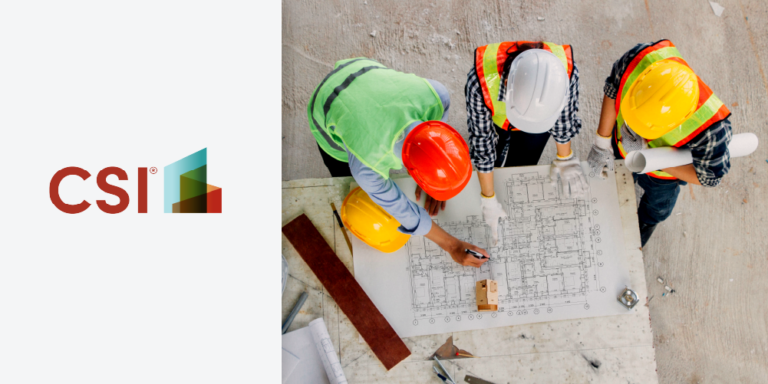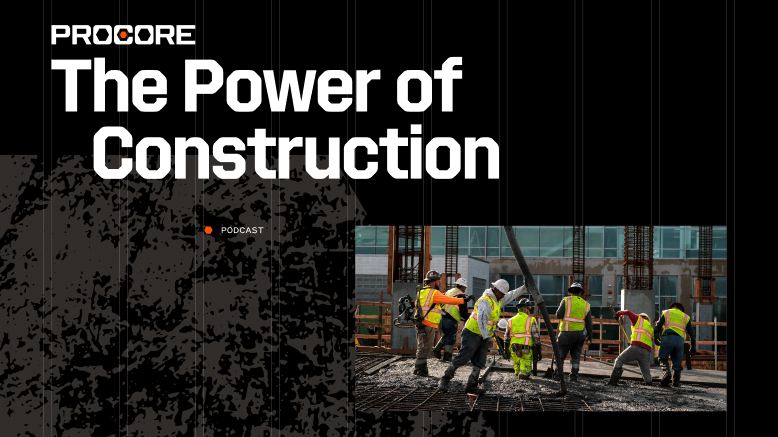— 11 min read
The Construction Specifications Institute (CSI): Standards, Training & Resources

Last Updated Aug 9, 2024

Taylor Riso
Contributing Writer
91 articles
Taylor Riso is a marketing professional with more than 10 years of experience in the construction industry. Skilled in content development and marketing strategies, she leverages her diverse experience to help professionals in the built environment. She currently resides in Portland, Oregon.

Mary Carroll-Coelho
Product Operations
12 articles
Mary Carroll-Coelho is a Product Operations Manager at Procore. A licensed Architect, Mary previously worked for KieranTimberlake, an architecture firm in Philadelphia, in construction and product operations at WeWork, and Director of Customer Success at Willow. She holds a Master of Architecture from the University of Pennsylvania. Outside of work, she volunteers as a mentor in the Spark program.
Last Updated Aug 9, 2024

Founded in 1948, the Construction Specifications Institute (CSI) is a national U.S. not-for-profit professional association whose mission is dedicated to improving communication in construction. With more than 8,000 members of construction industry professionals nationwide, including architects, engineers, contractors, product manufacturers, and other building industry experts, CSI is committed to the standardization of construction terminology and language, particularly around building specifications.
CSI focuses its work on three major areas:
- Creating standards and guidelines
- Certifying professionals at the industry level
- Producing learning materials, guides, and resources for construction professionals
In addition to providing a variety of tools and formats for standardization, CSI offers certification programs, continuing education courses, product shows, and networking opportunities through local chapters throughout the country.
CSI has worked closely with Construction Specifications Canada (CSC) to develop several recent standards, including MasterFormat and SectionFormat/PageFormat. As a result, CSI standards and guidelines are widely used throughout the building industry in the US and Canada. However, they have not gained widespread adoption beyond North America.
Read on for a detailed look into the history and role of CSI, standards and guidelines, and certifications.
Table of contents
History of the Construction Specifications Institute
Prior to the founding of the Construction Specifications Institute, architects, engineers, developers and government agencies employed their own methods to organize and describe specifications for construction. With the end of World War II and the rapidly growing economy, there was significant demand to invest in various new facilities and buildings. With this construction boom, there was a recognition that the lack of uniformity in construction documentation was reducing productivity and driving communication problems.
In 1947, the federal government hired a group of architects and engineers working to develop a unified communication system for the entire construction industry. As a result of these discussions, The Construction Specifications Institute was incorporated in the State of Maryland on March 8, 1948.
During its initial stages, CSI placed emphasis on standardizing and structuring construction specifications, aiming to facilitate efficient communication among all stakeholders involved in projects. The overarching objective was to establish a sense of uniformity and consistency throughout the industry. Another key objective of the institute was to shift the perspective and recognize construction specifications as an integral piece of the construction contract documents.
Attended by 45 active members, the inaugural annual meeting took place in 1948. Shortly thereafter, CSI began publication of The Construction Specifier on a quarterly basis. In May 1951, the Institute Board granted its first charter to the Metropolitan New York City Chapter. Subsequently, additional chapters were chartered for Metropolitan D.C., Chicago, Los Angeles, San Diego, and Sacramento.
In 1963, CSI developed The Master Specification System, a structured format for construction specifications, encompassing 16 major divisions of work. In 1975, it was officially named MasterFormat. As construction technology, processes, and materials evolved over the following decades, CSI began revising MasterFormat with updated specifications to accommodate the increased complexity. The organization continues to publish updates to MasterFormat as new materials and technology gain more widespread adoption.
Today, there are thousands of CSI members and more than 100 CSI Chapters located across the country. CSI has expanded its role in the industry and now also offers certification programs and educational resources for construction professionals. CSI maintains its commitment to advancing construction information in order to reduce errors and inefficiencies, propel progress and deliver successful project outcomes.
CSI’s role in the construction industry
Although CSI has evolved since its inception, it remains a pivotal force in the North American construction industry, fulfilling a variety of essential roles, including:
| Standardization | CSI continues to serve as the industry authority in standardization, driving uniformity and consistency in specifications. The institute ensures the ongoing responsibility for maintaining and updating the process and formatting of construction documentation. Systems such as MasterFormat, SectionFormat/PageFormat, and UniFormat serve as valuable tools for categorizing and organizing information within specifications. Utilizing these systems promotes standardization throughout the industry, leading to better project outcomes by enhancing clarity and minimizing miscommunication. |
| Continuing Education | CSI also offers a wide range of educational resources and programs that cater to a variety of construction professionals. These educational programs include in-person seminars, workshops and conferences as well as webinars and self-paced online courses. CSI often provides Continuing Education Units (CEUs) upon completion of their programs, which industry professionals utilize to maintain or acquire professional credentials or licenses. |
| Accreditation | CSI provides certifications that validate the knowledge and expertise of professionals in specific areas within the construction industry— including the Construction Documents Technologist (CDT), Certified Construction Specifier (CCS), Certified Construction Contract Administrator (CCCA), and Certified Construction Product Representative (CCPR) certifications. |
| Industry-Specific Resources | CSI offers a wide range of resources specific to the construction industry, including articles, publications, technical reports, and guidelines. While these help with the advancement of construction documentation best practices, they also serve as valuable tools and references for professionals looking to enhance their knowledge base, improve skills and adapt to industry changes. |
| Networking | CSI also provides networking opportunities with more than 100 chapters spread out across the nation. In addition to local chapters that host events and additional education opportunities, CSI also hosts an annual national conference. These networking events encourage professionals to establish connections, exchange ideas, and stay up-to-date on the most recent trends and advancements in the industry. |
| Advancement | Keeping with its origin story, CSI continues to champion the standardization of specifications and the implementation of best practices throughout the industry. With the recent advances in technology and the widespread adoption of building information modeling (BIM), CSI works to integrate these into the construction process. |
CSI standards
For the past 60 years, CSI has been instrumental in standardizing construction documentation across the industry. Today, the institute offers construction professionals a variety of standards to utilize in their specifications including MasterFormat, UniFormat, OmniClass and others.
MasterFormat
MasterFormat is recognized as the benchmark within the architecture, engineering and construction (AEC) industry, serving as the premier method of organizing specifications in the US and Canada. In fact, this standard was developed jointly by CSI and Construction Specifications Canada (CSC).
Commonly referred to as the “Dewey Decimal System” for construction, MasterFormat provides a coding system that includes 50 divisions, which are subdivided into sections with six-digit numbering sequences. This indexing system provides a systematic, standardized method of organizing specifications to improve communication between project stakeholders and minimize errors.
UniFormat
UniFormat provides a classification for building elements, systems, and assemblies, offering a comprehensive understanding of the design and management of a building throughout its entire lifecycle. During the initial design phase of a project, UniFormat is frequently integrated to facilitate cost analysis and documentation of various project elements, such as interiors, foundations, HVAC systems, etc. During preconstruction, this enables a systematic approach to tracking and estimating costs as well as evaluating different design options.
Learn more: The Step-by-Step Guide to Estimating
Teams commonly employ UniFormat during schematic design and design development stages, using its classifications to categorize and organize building elements and systems. As the project progresses, these classifications are then translated into MasterFormat. This seamless transition from UniFormat to MasterFormat ensures consistency and facilitates effective communication and coordination among project teams, stakeholders and contractors during the construction process.
SectionFormat/PageFormat
SectionFormat/PageFormat offers a suggested framework for structuring and displaying the content of construction specifications. The objective is to ensure uniformity and consistency in communicating design intent, thereby improving the clarity and usability of documentation while minimizing errors.
SectionFormat, often called a “three-part spec,” establishes a standardized approach for organizing specification text within the sections of a project manual. It employs a three-part format including:
- General or administrative information
- Required product (or manufacturing and sustainability attributes
- Site installation and execution requirements
PageFormat presents a recommended structure for the layout of text on a specification page. This framework promotes consistent presentation and identification of articles, paragraphs and subparagraphs as well as margins and page numbers.
Explore data and trends for building materials prices.
Get the latest U.S. retail prices and view historical trends for common building materials.
GreenFormat
GreenFormat provides a standardized framework for organizing and structuring information about elements related to sustainability in the built environment, including materials, products, systems and technologies. GreenFormat promotes the integration of sustainable practices by promoting consistent documentation and evaluation of environmentally-conscious solutions that examine their impact throughout the project’s entire lifecycle.
OmniClass
OmniClass offers a comprehensive classification system specifically tailored for electronic databases and software. Particularly effective for building information modeling (BIM), its versatile classifications can be effectively employed to streamline the organization of library materials and establish frameworks for electronic databases.
CSI certifications
CSI also offers a variety of certification programs for construction professionals.
Construction Documents Technologist (CDT)
The Construction Documents Technologist (CDT) certification demonstrates a professional's understanding of the foundational knowledge and principles related to construction documentation and project delivery. This certification recognizes the individuals’ comprehensive understanding of construction documentation from creation to interpretation to coordination. Obtaining the CDT certification is often a prerequisite for individuals pursuing higher-level certifications with CSI.
Certified Construction Specifier (CCS)
The Certified Construction Specifier (CCS) certification confirms a professional's advanced knowledge in the development and management of specifications. It specifically assesses their ability to analyze and pinpoint cost-effective and efficient solutions, and successfully convey those through the specifications.
Certified Construction Contract Administrator (CCCA)
The Certified Construction Contract Administrator (CCCA) certification is focused on administration and management of construction contracts. Professionals with CCCA certifications demonstrate a high level of knowledge in quality assurance and quality control, bidding and negotiating, construction observation and inspection, general and supplemental conditions and contract enforcement and liability.
Certified Construction Product Representative (CCPR)
The Certified Construction Product Representative (CCPR) certification is directed more toward professionals in the industry who are engaged in selling and creating construction products and materials. Created for manufacturers, suppliers, or distributors of construction-related products, the CCPR certification demonstrates professionals' expertise as knowledgeable and trusted resources for product information and guidance. For individuals with CCPR certifications, it is a requirement to hold dual certification with CSI’s CDT.
Overall, CSI's certification programs aim to support the professional development of individuals in the AEC industry, validate their unique skills and depth of understanding, promote industry-wide best practices, and foster collaboration and excellence throughout the entire construction process.
CSI practice guides
CSI also provides practice guides that can be used as resources for gaining knowledge and insight, as well as study guides for their various certification programs.
The Project Delivery Practice Guide (PDPG) thoroughly explores the wide range of project delivery methods, covering the roles and responsibilities of different project stakeholders, project phases and effective strategies for achieving successful project outcomes. In addition, the PDPG serves as a valuable resource for professionals seeking their Construction Documents Technologist (CDT) certification.
The Construction Specifications Practice Guide (CSPG) offers a comprehensive and in-depth examination of the creation and application of high-quality construction documentation. It also serves as an essential study aid for professionals preparing for the Certified Construction Specifier (CCS) certification examination. This provides guidelines for all construction professionals who utilize and work with specifications.
The Construction Contract Administration Practice Guide (CCAPG) serves as a comprehensive resource for understanding and effectively administering construction contract documentation. This guide examines contract administration throughout the entire construction process, beginning in preconstruction and extending through to project closeout. CCAPG also serves as a resource for individuals studying for their Certified Construction Contract Administrator (CCCA) certification.
The Construction Product Representation Practice Guide (CPRPG) examines the variety of products used in construction, how to convey product information, and best practices for their specification in construction documentation. This guide is often used by product or manufacturer representatives to obtain the Certified Construction Product Representative (CCPR) certification.
The importance of standards for construction
Since the inception of CSI, the construction industry has experienced remarkable strides and advancements. In the past several decades, there has been a significant shift towards embracing innovation, improving efficiency and enhancing overall construction practices. Many of these changes are a direct result of CSI’s push towards standardization.
With the world becoming increasingly interconnected, the forces and players that impact construction projects are no longer limited to local or regional boundaries. Standardization, through uniformity and consistency in language, facilitates knowledge sharing and innovation beyond borders.
Moreover, the growing emphasis on standardization across industries has played a vital role in driving additional efficiencies in construction. Standardization establishes common frameworks, guidelines and specifications that ensure consistency, quality and safety in construction. By adopting and implementing these standardized practices, materials and processes, contractors can streamline their operations, minimize errors and boost productivity.
These influences are propelling the industry forward — creating a landscape of continued progress and innovation, improved communication and collaboration and enhanced project outcomes.
Was this article helpful?
Thank you for your submission.
100%
0%
You voted that this article was . Was this a mistake? If so, change your vote
Scroll less, learn more about construction.
Subscribe to The Blueprint, Procore’s construction newsletter, to get content from industry experts delivered straight to your inbox.
By clicking this button, you agree to our Privacy Notice and Terms of Service.
Thank you!
You’re signed up to receive The Blueprint newsletter from Procore. You can unsubscribe at any time.
Categories:
Written by

Taylor Riso
Contributing Writer
91 articles
Taylor Riso is a marketing professional with more than 10 years of experience in the construction industry. Skilled in content development and marketing strategies, she leverages her diverse experience to help professionals in the built environment. She currently resides in Portland, Oregon.
View profileReviewed by

Mary Carroll-Coelho
Product Operations
12 articles
Mary Carroll-Coelho is a Product Operations Manager at Procore. A licensed Architect, Mary previously worked for KieranTimberlake, an architecture firm in Philadelphia, in construction and product operations at WeWork, and Director of Customer Success at Willow. She holds a Master of Architecture from the University of Pennsylvania. Outside of work, she volunteers as a mentor in the Spark program.
View profileExplore more helpful resources

What Happens When Data Drives the Business?
Construction has long been seen as a low-margin industry. But what if the real problem isn’t the margins—it’s how decisions get made? In episode 17 of The Power of Construction,...

Preconstruction Partnerships: How Safety Pros Can Collaborate with Estimating & Proposal Teams
Construction leaders and safety professionals are developing a strong understanding of how safety programs positively impact project outcomes. When safety is woven into every aspect of operations from pre-construction to...

Types of Construction Specifications: Understanding the Difference
On a construction project, the specification book, often referred to as the “spec book,” typically contains detailed descriptions of the materials, products, systems and workmanship required. The design team —...

Constructability Reviews: Moving From Design to Reality
Before concrete is poured or hammers are swung, a construction project requires the proper scrutiny to determine if the project is even possible. This is where a constructability review comes...
Free Tools
Calculators
Use our calculators to estimate the cost of construction materials for your next project.
Templates
Find a template to help you with your construction project tasks.
Material Price Tracker
Get the latest U.S. retail prices and view historical trends for common building materials.
Glossary
Explore key terms and phrases used in the industry.
